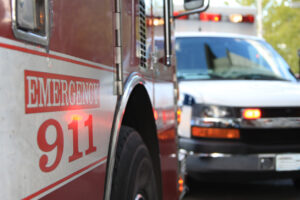Task Force Answers the Call for EMS Support
When most Minnesotans call 9-1-1, they expect to quickly receive help from emergency medical services (EMS) workers and other first responders. 
But those expectations are becoming further from reality in some parts of the state as EMS stresses pile on and ambulance response times are delayed due to consolidated services and expanded coverage areas. Some communities even face the possibility of losing their ambulance services.
How could such a vital service disappear altogether in some parts of Minnesota? Ongoing workforce shortages and trying to make do with inadequate funding have stretched the EMS system so thin that it’s nearing its breaking point.
“The pandemic really took an already stretched system and just added so much weight to it that we’re starting to see some of the foundations crumble,” said Michael Juntunen, president-elect of the Minnesota Ambulance Association (MAA) and coordinator for Mayo Clinic Community Paramedicine.
Juntunen shared that some ground ambulance services receive local funding, but the vast majority rely on reimbursement from public medical programs that fail to adequately cover the cost of EMS services.
“(EMS has) moved from just being a transportation service into a more health care delivery service where we’re providing a lot of emergent care that is not all that different from what you would experience in an emergency room,” Juntunen said. “We have all the major equipment to help with any major issue someone is having, but we’re still paid as a transportation service.”
While the quality of services EMTs and paramedics are expected to provide has risen, Medicare reimbursement rates have remained stagnant, leading to inadequate funding needed for equipment, training, and livable wages for EMS workers. Though Juntunen shared reimbursement issues will need to be resolved at the federal level, he knows those at the local level can no longer ignore the realities of first responders’ stresses and lacking resources.
Creation of the Minnesota EMS Delivery and Sustainability Task Force
During the 2023 Legislative Session, stakeholders from the League of Minnesota Cities, MAA, the Minnesota State Fire Chiefs Association (MSFCA), and the Minnesota Association of Small Cities (MAOSC) came together to propose the creation of a task force dedicated to addressing EMS issues and suggesting solutions. The task force consists of 19 stakeholders and has met biweekly since Sept. 6, 2023.


Juntunen and Edina Fire Chief Andrew Slama were named co-chairs of the task force, which plans to meet for several months.
“We have agreed that any recommendation coming out of the task force will be unanimous among all stakeholders,” Slama said. “That in itself is a really tall task and speaks to the gravity of these stakeholders working together to provide a solution that meets everyone’s needs and is mission-driven. That mission being to better the service for residents in Minnesota.”
Slama explained that the entire EMS system is impacted when ambulance response times are delayed. If a police officer responds to a 9-1-1 call and must wait 45 minutes for an ambulance to arrive, that’s 45 minutes that officer can’t respond to other emerging calls.
“It delays the entire system when one portion of it isn’t able to fulfill the duties as they would like to or as they should or as the community would expect them to,” Slama said.
According to Slama, delayed ambulance arrival times aren’t just occurring in Greater Minnesota. Metro areas have struggled with larger call volumes and workforce shortages, forcing stakeholders to adjust their responses. This adjustment in response does not require any communication with the community they are responding to or local responders creating further challenges in the public safety response model.
Juntunen shared that in most departments, EMS crews are sent out almost immediately for every 9-1-1 call, no matter its level of urgency. Task force members have suggested gauging the urgency of each request and saving crews’ last available ambulances for high-priority calls.
“When that cardiac arrest call comes in, we might be delayed getting to it,” Juntunen said. “We should probably have a safety net there—especially in our urban areas—to make sure that that’s met. We need to look at ways to really evaluate the impacts of that change and whether it would be appropriate.”
Slama said that while the task force’s stakeholders may have differing priorities for mending the state’s EMS system, they all agree on their inability to continue doing the same things and expecting different results.
“Innovative ideas that challenge the current ideals are going to be what gets Minnesota to a new system that can deliver better service,” Slama said.
What Can Be Done at the Local Level
Juntunen acknowledged the strides made toward EMT and paramedic recruitment during the 2023 Legislative Session, including receiving funding for scholarships and pushing for programs that introduce high school students to the profession. This year, he wants the Legislature to pass a funding bill to help alleviate some stresses regarding affording new equipment, removing recruitment barriers, and offering EMS workers livable wages.
Slama shared his excitement for the task force’s discussions on local input and accountability, noting that there is no one-size-fits-all solution to the nationwide EMS crisis.
Juntunen and Slama agree that while local legislators and city leaders can’t make direct changes to increasing Medicare reimbursement rates, they can educate themselves and their communities on the barriers first responders face.
“Out in rural Minnesota especially, I would say that they need to start engaging in conversations with the ambulance services that cover their area,” Juntunen said. “Even if they can’t help financially because of their own constraints, just having some conversations about the industry would be beneficial.”
Slama encourages local leaders to dive deep into educating themselves on their communities’ EMS system’s operations and barriers.
“Talk to municipal-based, fire-based, and hospital-based providers about their challenges, so that you can develop a really thorough understanding of challenges,” Slama said. “Get informed on multiple different sides of the challenge, because it’s not a one-size-fits-all solution.”
The League will continue to advocate for funding and policy solutions that recognize different EMS models and support EMS statewide during the 2024 legislative session. The League will also engage in the work of the Minnesota Legislature’s Joint Task Force on EMS. For more information, please contact League Intergovernmental Relations Director Anne Finn at (651) 281-1263 or [email protected].

